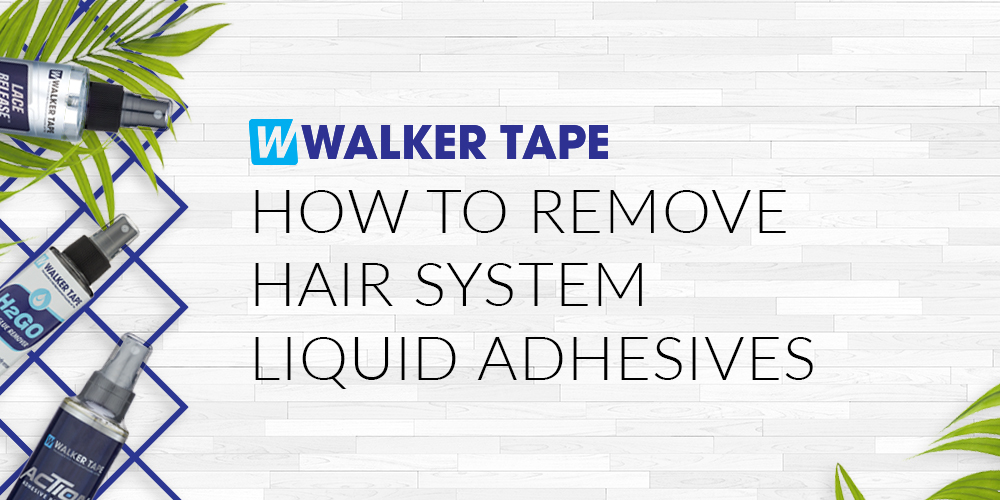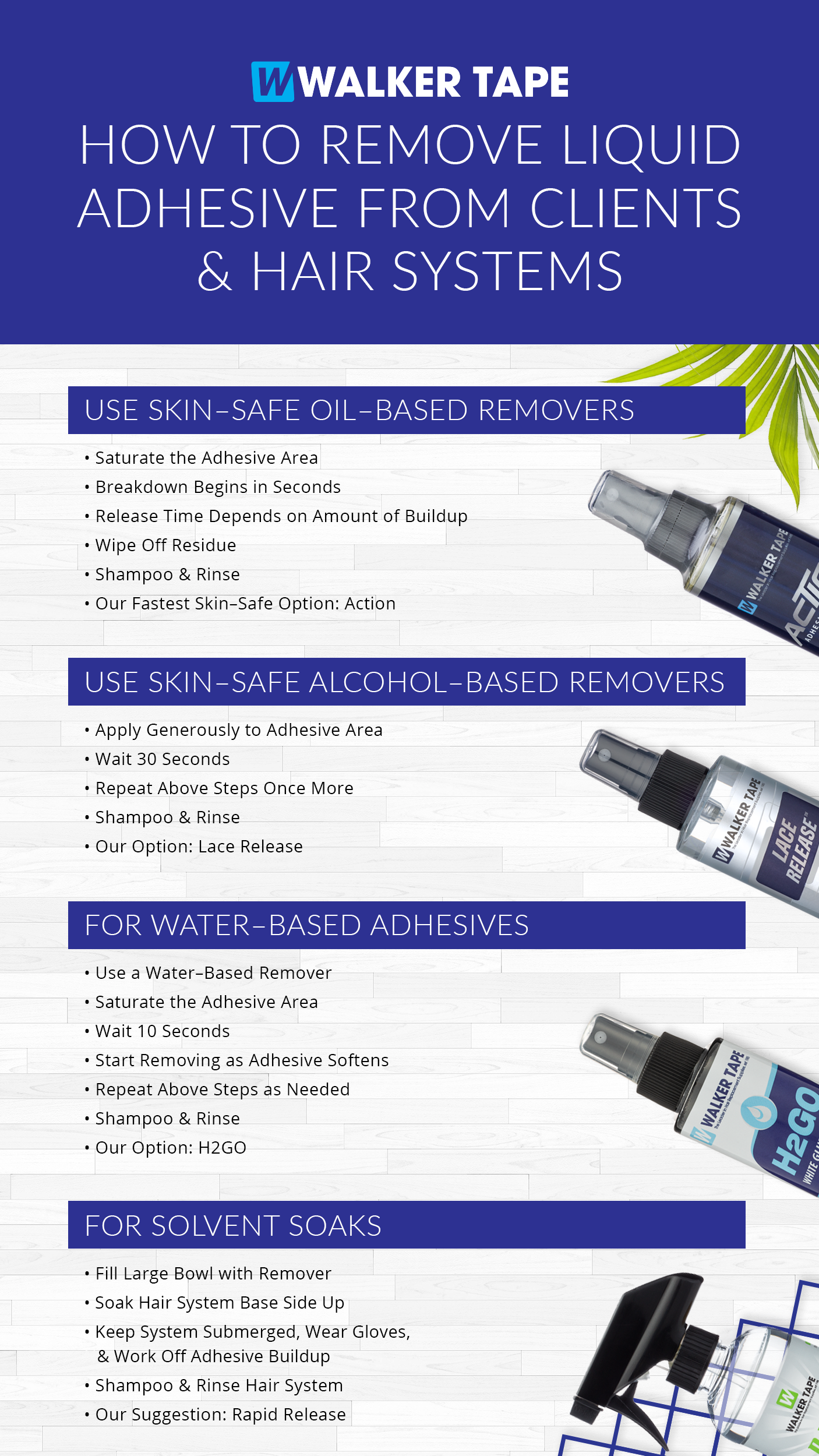
To begin, let’s just give you a shout out for needing to remove a hair system in the first place. This is a great indicator that your clients are coming back. Getting returning clients is a feat that deserves to be celebrated. So, way to go!
It’s also great that you’re looking for the best and safest way to remove the system. That will help ensure that your clients keep coming back to see you.
So, to help you achieve the best removal possible, let’s go over some tips and tricks to remove liquid adhesive-held hair systems.
Removing Hair Systems from the Liquid Adhesives on Your Client’s Scalp
To start with, you’ll need to remove the hair system from your client’s scalp. The method of doing this can change depending on the kind of remover that you’re using.
When picking the right remover for your client, be sure you’re picking one that’s safe for your client’s skin. This means that you’ll need to perform a skin patch test, especially if your client has very sensitive skin.
Oil-Based Removers
Start by saturating the adhesive area with your oil-based remover, such as C-22 Solvent. This gives them the chance to start breaking down the adhesive.
The breakdown starts almost immediately. The time that it takes to fully release could depend on how much build up there is on the scalp. You may have to test it a few times by pulling softly on the system to see if it has released.
Our fastest oil-based, skin-safe option is Action.
Alcohol-Based Removers
You use an alcohol-based remover by liberally applying it to the adhesive area. Next, wait for about 30 seconds.
You’ll need to apply it again and then wait for another 30 seconds. After that, you can gently lift the system away from the scalp.
If you’d prefer to use an alcohol-based remover, we would recommend trying Lace Release.
Water-Based Removers
In order to use a water-based remover, the adhesive that’s being removed also needs to be water-based. Otherwise, you will need to use either an alcohol-based or oil-based option.
Like the others, start using water-based removers by saturating the adhesive area with it. Give it about 10 seconds to start breaking everything down. After some time has passed, you can start removing the system. You may have to repeat these steps a few times to make sure that no residue is left.
When looking for a water-based adhesive, we would recommend trying H2GO.
Removing Liquid Adhesives from Your Client’s Skin
Once you get the system off of your client’s scalp, there will still be some adhesive residue left on their skin. Luckily, most of our removers are skin-safe, so you can use them to remove the left-over residue.
Again, the way you do this will change depending on what kind of remover you use.
Oil-Based Removers
To remove adhesive using oil-based removers, you simply spray the remover on the area. Give it a little bit of time to breakdown the leftover product.
After that, you’ll just need to wipe off the residue. Then simply shampoo and rinse your client’s bio hair. You can repeat these steps to make sure you get the adhesive off of your client’s skin and out of their bio hair.
Alcohol-Based Removers
Alcohol-based removers are just as simple and easy to use as our oil-based options.
Spray the adhesive area with the remover. Give it about 30 seconds to start breaking the adhesive down. Then, you can wipe the adhesive off and shampoo and rinse the bio hair. Repeat these steps if there is still some remaining residue.
Water-Based Removers
Like mentioned above, these removers are really only best used with water-based adhesives.
To get the residue off, you’ll need to spray the area with the adhesive remover thoroughly. Give it only about 10 seconds, and then you can try wiping away the residue.
Then, simply shampoo and rinse the bio hair.
When removing the left-over adhesive from your client’s skin, it’s even more important to use a skin-safe remover. After all, this will be going directly onto their skin. So, be sure to take a look at our suggestions listed above. They are all tested to be skin-safe.
Removing Liquid Adhesives from the Hair Systems
After you’ve removed the system and residue from your client’s scalp, there is likely to be some adhesive still on the unit. You’ll need to remove that residue to make sure that you can reuse it.
Oil-Based Removers
To remove adhesive using oil-based removers, you really only have to follow the same instructions listed above.
You need to spray that remover onto the area with the adhesive, give it some time, then wipe it off. After that, you will need to shampoo and rinse the unit as well. For this, we recommend using our Bond Breaker Shampoo. It will help break down the adhesive stuck to the unit.
Alcohol-Based Removers
Again, this is all very similar to earlier instructions. You simply need to spray the remover onto the unit, wait around 10 seconds, then wipe it off.
You will also want to shampoo and rinse the unit. Bond Breaker Shampoo is made for this exact purpose.
Water-Based Removers
You can probably guess where we’re going with this!All you need to use is spray the remover on the adhesive, give it 30 seconds, and then wipe it off. Be sure that you shampoo and rinse it as well using Bond Breaker Shampoo.
Solvent Soak
Another way that you can get rid of the adhesive residue in the hair system is through a solvent soak. These soaks involve more harsh solvents, so this works best once the hair system has been fully removed from your client.
To do a solvent soak, start by filling a large bowl or sink with remover. Then, place the system in, base side up. Keep the system submerged and, while wearing gloves to keep your hands out of direct contact with the solution, work the adhesive build up off.
After that, make sure you shampoo and rinse the system to make sure the solvent is completely gone.
The solvent we recommend using for these types of soaks is not skin safe, so try not to get it on your or your client’s skin.
Our best solvent for this is Rapid Release, because it is our fastest acting solvent.
After washing with Bond Breaker Shampoo, remember to let your client’s system air dry in order to keep it in the best condition. Also, use a bit of our Leave-In Conditioner to bring back the hair system’s shine.

If you follow the instructions above based on your preferred application method, your clients are sure to keep coming back! Still have some questions about removing liquid adhesive? Contact us! From there, we’ll be able to find a solution that best helps you and your clients.





Hi just wanted to say I use C-22 on every type of adhesive I’ve tried them all and C-22 works the best. I spray on leave it on for a few minutes then use paper towels to remove any residue very easy and uses less product just need a little hand muscle to wipe and clean.
That is so great to hear! C-22 is one of our favorites as well. Thank you for letting us know your feedback
do you have the bond breaker shampoo in stock?
Yes! Both our gallon and 10oz options are available now